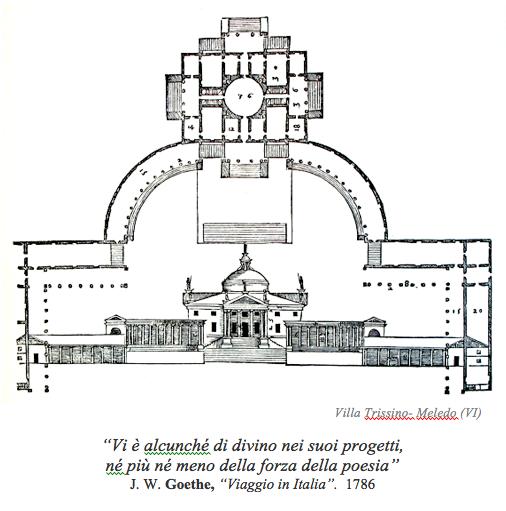
ANDREA PALLADIO (PADUA 1508 - VICENZA 1580)
- Andrea di Pietro, called "Palladio", was born in Padua on 30th November 1508, in a modest family:
he is the son of Pietro della Gondola and Marta la "Zota" (crippled). At age of 13,
he started his artistic experience as stone cutter in the workshop of the sculptor from Padua
Bartolomeo Cavazza da Sossano. In 1524 he moved to Vicenza and he worked as apprentice
in the workshop of Giovanni da Porlezza and Girolamo Pittoni da Lumignano. This humble education
influenced his future activity of architect. In 1538 he met the noble G.G. Trissino.
This meeting changed Andrea′s life. The noble humanist became the main patron of young Andrea,
from that time called "Palladio": an elegant name from Greek mythology. The first projects in Vicenza
were the Palaces: Thiene, Porto e Chiericati. The City changed its Gothic appearance to become
rapidly one of the most important centre of architecture of Rinascimento. The project for the
recostruction of Logge of the Basilica was the most significant work in the city. The most important
architects were called: Giulio Romano, Iacopo Sansovino and Sebastiano Serlio. But the Consiglio Cittadino
chose the project of young Palladio (1549). The building was completed only after Palladio′s death.
After 1550 the period of classical villas started. The most famous villas are: villa Pisani in Bagnolo (1542),
villa Pojana (1549), villa Pisani in Montagnana (1554), villa Cornaro in Piombino Dese (1556),
villa Badoer in Fratta Pol. (1557), villa Almerico Capra the "Rotonda" in Vicenza (1556),
villa Emo in Fanzolo (1558), villa Foscari "Malcontenta" in Mira (1564) and villa Barbaro
in Maser (1563), with paintings of Paolo Veronese.
Reached the full artistic maturity, he obtained the first official recognitions: in 1556 he was one
of the 21 founders of Accademia Olimpica in Vicenza. In 1570 he was in Venice in order to stand
in Sansovino for the office of Proto dell′Architettura, responsible for the public
buildings in Serenissima.
The period of sacred buildings started: the façade of San Francesco della Vigna, the church
of San Giorgio Maggiore and the church of Redentore in Giudecca. In the same year he published
on his own the treatise "I Quattro Libri dell′Architettura":
he wrote about his technical knowledge and his realized projects.
In 1575 he returned to Vicenza and worked to the drawings of Teatro Olimpico.
It is one of the first stable theatre in Europe and it′s known all over the world. His innovative work
was admired from a lot of pupils and followers. It spread in Italy, in anglo-saxon countries and in the USA,
where many buildings are projected according to the Palladio′s style. P.R.
|



